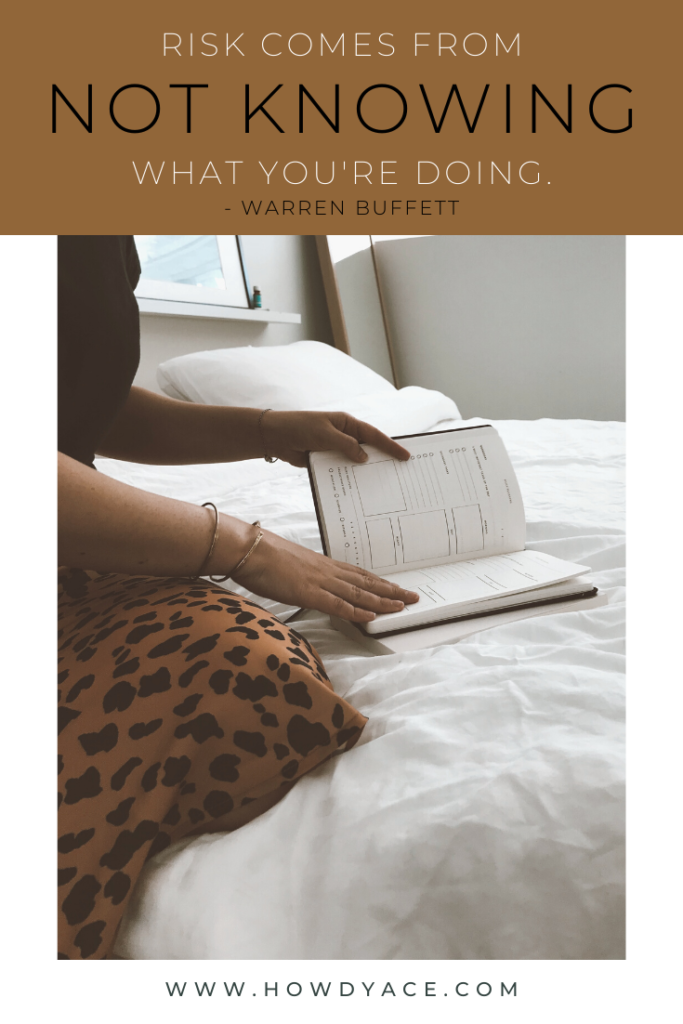
Create Your Debt Repayment Blueprint
After college, if someone were to ask about my debt repayment blueprint I would have awkwardly laughed and changed the subject. It was my defense mechanism to get over the fact that I had no idea.
The truth was that my debt repayment plan was nonexistent. I didn’t even know where to start.
Since I had no idea what I was doing, it took a lot of time to learn and practice.
With a lot of trial and error, I kept learning what worked for me. My knowledge continued to build and I found myself with a debt repayment blueprint.
Soon enough, as the momentum built quickly, I was officially debt-free. It felt as if a huge boulder had been lifted off my shoulder. I was ecstatic.
Looking back now, it was clear that getting organized, creating a debt repayment blueprint, and determining a strong reason why was critical to my success.
If you are on the journey of becoming debt free, follow along to learn what steps helped me below.

Gather Your Debt Repayment Information
Take some time to gather all the relevant information for all outstanding debt. Here is what needs to be gathered:
-
-
- Who you owe:
- Website:
- Username:
- Password:
- Address (if paying by mail):
- Website:
- How much you owe:
- Total balance:
- Outstanding balance:
- Minimum monthly payment:
- Interest Rate %:
- Fixed or Variable?
- Payment Date:
- Statement Date:
- Payment Policies:
- Understand how payments are applied?
- Understand how EXTRA payments are applied?
- Late fees/penalties:
- Who you owe:
-
Excel or Google Drive
I highly suggest creating an Excel or Google Drive sheet since there are so many benefits.
-
- Only have to input the information once
- Easily saves and updates
- Clean and organized
- Ability to sort and filter
- Powerful advanced formulas can be added later
You can download my free Google Drive Sheet below. If pen and paper are your jam, feel free to go that route. The important thing here is to gather all the information and have it present in one place.
[convertkit form=1175629]

Prioritize Debt Repayments by Payment Methods
Now that we have taken the time to piece together all the information, it’s time to review and strategize. There are two popular debt payment methods: debt stacking and debt snowball.
Debt Stacking
Debt stacking is also known as the debt avalanche method. This method requires us to rank our debts by interest rates, starting with the highest to the lowest. The Balance provides a great example in their debt strategies article,
“We might owe:
-
- Mastercard, $2,500—19%, highest interest rate
- Visa, $7,500—13%, second-highest interest rate
- Car loan, $4,000—8%, third-highest interest rate
- Student loan, $1,900—5%, lowest interest rate
The debt stacking method advises that you make the minimum payment on all your loans. Then, you should throw all of your extra money toward paying off your Mastercard, which has the highest interest rate, at 19%.”
Once we’ve paid off the Mastercard, we’ll continue to pay the minimum payments on all debts but throw any extra money toward the next highest loan. In the example above, it would be the Visa at 13% interest.
The benefit of this method is that it saves the most money in the long run. It prevents high interest payments from accumulating as fast. Since my goal was to stop accumulating more debt, I went with this method.
Please note if the high interest balance is high, it could take some time to completely pay off the debt. Many do not get the psychological/visual satisfaction compared to the debt snowball method mentioned next.
Debt Snowball
In this method, we rank our debt by the balance instead, starting with the smallest to the largest. Using the same example provided by The Balance:
“You would re-order the above list as follows:
-
- Student loan, $1,900—5%, lowest balance
- Mastercard, $2,500—19%, second-lowest balance
- Car loan, $4,000—8%, third-lowest balance
- Visa, $7,500—13%, highest balance
You’d make the minimum payment on all your loans. Then, you’d throw every extra penny toward the debt with the smallest balance, regardless of the fact that, in this particular case, it also has the lowest interest rate.”
The benefit of this method is more of a mental/visual feeling of victory. By paying off the smallest debt, it will bring a sense of accomplishment. It builds momentum that motivates us to keep going. The downside is that it could end up costing a lot more due to only paying the minimum on high-interest debt.

Create Your Debt Repayment Blueprint
After reviewing both repayment methods, decide which one to go with. Then, create a game plan. Write down all the steps needed to make it happen. It’ll be useful to help keep us on track and measure progress.
Make sure to pay all the minimum payments on each debt, and then throw any extra to the debt with the highest interest or lowest balance. Once we’ve completely paid off one debt, take a little time to celebrate! Do a little victory dance! Then, tackle the next highest interest or lowest balance. Tackle, Celebrate, and Repeat. Keep on going until we are completely debt-free!
Keep in Mind
Another important part of becoming debt-free is to stop accumulating more debt. That means that we must live within our means and stop borrowing money. The best way to do that is to save + budget or find other opportunities to increase our income. My suggestion, get creative and do both!!
It’s okay to try one method and switch to the other if one method does not work for you. There is a reason why it’s called personal finance; it is completely personal to you. What works for one person may not work for another. It may take some trial and error, but don’t give up, you will figure it out! The most important thing is learning what works for YOU.
Pay Your Debts with Gratitude
Now for the best part, once we have our game plan, we must pay our debts with gratitude! This was very hard for me to do and it took me a long time to understand the value of this. I used to hate seeing debt, thinking about debt, paying debt, and everything else that came with it.
The negativity was bringing me more into a negative spiral, so I had to change my relationship and attitude with debt. With each payment I sent off, I became more grateful. I would say things like:
- “I’m grateful that I have the money to pay this month’s student loan which allows me to have a better future.”
- “I am grateful to be able to afford this month’s car payment that helps me to get from one place to another.”
- “I’m glad that I can pay for this week’s groceries that will feed me for the entire week!”
Sounds crazy, but do it enough and it’ll change your outlook! I promise! It was fun to get creative and silly with it. Paying back debt does not have to be something that you dread unless we make it that way!
In reality, many people aren’t able to afford to pay their debts or even enjoy the simple luxuries that we take for granted. This is a great time to be thankful for what we have and see all the positive around us.

Always Make Debt Repayments On Time
There are so many negative consequences when we don’t make our debt payments on time. Depending on the lender, one late or missed payment could significantly increase the interest rate, finance charges, or lower our credit score.
If we have collateral (i.e. house or car), many lenders are quick to repose their assets to mitigate their risk. So to the best of our ability, always pay debts on time.
It’s best to pay off the entire balance but I know that is not always possible at first. If we can’t afford to pay the entire amount, make sure to pay at least the minimum payment (on all debts) to keep all accounts in good standing.
Payment Date + Tips:
Here are some tips to help prevents late fees + penalties and make sure that we never miss a payment.
- Put all the payment dates on our calendar with a notification.
- I usually made two notifications, one that was 4-5 business days ahead and one the day before. The first notification gave me enough of a cushion to transfer money between banks without being late. The second notification was a safety reminder to pay the debt in case I was waiting for money to transfer or just had not paid the debt.
- While we are at it, if we have a consistent pay date, add that into the calendar as well.
- Change your payment dates
- Most credit card companies and debt providers will let you adjust your payment date. All it takes is a simple phone call or click of a button. This helps reduce the number of dates that we have to juggle. Instead of 6 different payment dates, we can consolidate all the dates (I.E. 1st and/or 15th of the month, or close to whenever we get paid). When the date comes every month, we know it’s time to pay all the debts.
- Set debts on auto-pay.
- I highly suggest putting all debts on auto-pay if they provide that option. It is one less thing that we have to keep track of and we do not have to worry about missing a payment. Just make sure that we have enough money in the account to pay off the debt.
- Pay debts on the same day every week.
- For example, each Friday I pay off all my credit card debts. I just recently started to do this to help stay on top of my spending. Before I would only check my statement once and always be shocked by how much I spent each month. This helps me to keep a closer eye on how much I spend each week without going overboard. Paying every week prevents me from having to remember when to make a payment.
- If you do miss a payment….
- It happens to everyone, so let’s give ourselves some grace. The best thing to do is to get on the phone with someone from the debt company RIGHT AWAY! Do not wait. Talk to someone to see what they can do to help mitigate the blow.
- If it is the first missed payment, they can typically waive the late fee and prevent it from being reported on your credit score. This simple call is worth preventing all the negative consequences that could happen.
- Then, take some time to reflect on why we missed the payment and how we will prevent that from happening again in the future. What steps will we put in place to ensure success for the future?
BONUS TIP:
- Credit cards usually have the highest interest rates of all debts. Most people do not know that we can contact our credit card company and negotiate our APR (Annual Percentage Rate).
- I’ve done this online by chatting with an online representative through the main website. They take a minute to work their magic and I always come back and ask, “Is this the best that you can offer?” or “Can you do better?” Sometimes the can, sometimes they can’t…. online. They will tell us that if you call and speak to a representative, they may be able to offer a better/lower rate. It is something definitely worth trying and could save THOUSANDS of dollars if we have high consumer debt. In other words, it’s definitely worth doing.
- Make sure to listen and understand the new offer. We always have the option to ask questions for clarification or decline completely. If they can’t offer a better offer, call again in a few months and try again.

Make An Extra Payment
Our goal is to get out of debt and stop living paycheck-to-paycheck, so throw as much money as we can at debt. What helped me turbocharge through my student debt was to understand how payments were applied and making an extra payment a month. It really made a dent.
Read the Fine Print
This is where it literally pays to understand the fine print and read the policies. When I was first able to make an extra payment towards my student loans, I was so excited. I assumed that the principal balance would significantly decrease and so would my interest.
Instead, my principal balance stood still and my extra payment went toward paying future interest. My mouth dropped to the floor. The extra payment I worked so hard to save literally did nothing.
There Are Always More Options
I realized that many loans have a default payment method. With each payment, a portion goes to fees, another towards interest, and then the rest towards paying down the balance. We can find the exact allocation of each debt by reading the fine print.
In the fine print, I was also able to read about extra payments and how they are applied. My lender specifically stated that extra payments would be applied by the company’s default option unless specified by the payee.
With the default option, the power was completely in lender’s favor. All extra payments went towards future interest. So tricky!! I simply called the lender to clarify my questions, see what other payment options were available and specified how I wanted extra payments to be applied.
Trial and Error
It took a couple of tries but I finally realized how to make the biggest impact on my balance. By understanding and clarifying how extra payments were made, I significantly reduced the length and total interest on my student loans.
Instead of the standard 10-year repayment and $10,000+ in interest, I was able to pay my student loans in less than 2.5 years and only $2,543.73 in total interest. Keep in mind, that I had to live well below my means to make an extra payment each month.
Take a look at the information gathered earlier and make sure you understand how payments are applied and where extra payments go. This strategy alone will help save lots of time, money in interest, and turbocharge your debt repayment plan.

Your Compelling Reason Why
What kept me going when times were hard was my reason why. There will be times when it’ll be hard to see where all our hard work is going. But at the end of every storm, there is always a beautiful rainbow.
I suggest determining the reason why you decided to get on this journey out of debt in the first place. To get to the root cause, ask yourself “Why?” five times. For example:
-
- Why do you want to get out of debt?
- So I can quit my job
- Why?
- To find another job that will make me happy
- Why?
- One that allows me to create my own schedule
- Why?
- So that I can spend quality time with my loved ones
- Why?
- So that I never regret missing out on this special season of there lives that I only get to experience once in a lifetime.
- Why do you want to get out of debt?
Your compelling “why” will be enough to help motivate you when the times are tough. It is not something that should be taken lightly since your life literally depends on it. So take some time to figure out your “why.”
Bird’s Eye View
This is how the debt game changed for me. Once I had all my debt information in one place, I was able to see everything so clearly. It was out of my head and in front of my eyes for quick comparison. It was easy to distinguish which debts I needed to pay first and create my debt payback blueprint.
The end was in sight and I could finally see the bigger picture. I know that you can absolutely find it too! There are so many resources out there; it’s just a matter of finding out what will work for you! I hope this article gave you a good place to start!
Let’s Talk About It:
Which method will you use to pay down your debts?
What other tips have helped you on your debt-free journey?
I’d love to hear your feedback. Please leave a comment below or shoot me an email at connect@howdyace.com. If you found this information helpful and know someone who could benefit, don’t hesitate to let them know. Share this post with them!
If you haven’t already, subscribe below to get more so that you’ll never miss a post!
[convertkit form=1205270]
Thank you so much for sharing your time and energy with me!


0 Comments